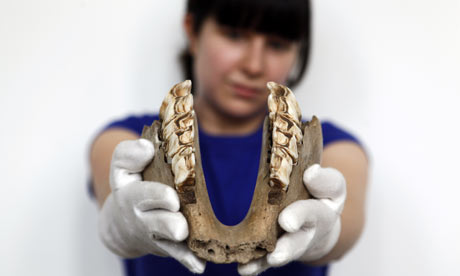
A National Ice Age Centre? What could be better for a warm late summer weekend? For the first time in Britain, a visit to the shivering world of 13,000 years ago has become possible. Cool in every other sense, the new £7m complex at Cresswell Crags near Worksop was launched in June by Sir David Attenborough.
Light, bright and full of dagger-shaped teeth and mammoth bones, the centre overlooks a remarkable limestone gorge where Neanderthal man went hunting. Caves with names such as Robin Hood's Cavern and Church Hole pockmark cliffs above a mass of wildflower banks and a lake created by the Neanderthals' successors, the Dukes of Portland, to shoot ducks.
The strange little landscape is part of the estate of Welbeck Abbey, a rambling (and still private) mansion famous for underground rooms created by the disfigured fifth duke, who could not bear to be seen. Local people have always known about it, and the mile-long circular walk between the cliffs is a favourite stroll. But it didn't hit the national headlines until 2003.
That year, a group of archaeologists found the oldest artwork in the country in three of the caves, delicate engravings of reindeer, bison and birds which had been overlooked in the chaos of crumpled stone which forms the roofs and walls. Even the artist George Stubbs, who stayed at Welbeck and set his famous painting of a horse and lion at the Crags, missed them. "Mind you, at the time the caves were being used as barns for the ducal cows," says one of the new centre's curators, Dr Rebecca Clay. "In fact some of them rubbed part of the bison away."
Wearing a miner's helmet, lamp – and if it's a school party, Ice Age-style sewn furs – Dr Clay tramps up the ladders leading guided tours to see the startling discoveries. The find gave fresh energy to a small but determined group of enthusiasts who tried to win World Heritage status for the gorge 20 years ago.
"They set us three conditions: to move a local sewage plant, divert a road and build a proper centre," she says. When Attenborough blessed the new centre, after examining its vicious-looking hyena skulls (the Ice Age version of the animal was nearly twice as big as today's), all three challenges had been met. A second application for World Heritage status is ready to go.
Half the centre is set aside for schools, and has all manner of ingenious ways to sneak archaeology into the national curriculum, in which it still has no official place. Using art, dance, history and natural sciences, the Ice Age team will battle on against unscholarly foes such as the new Hollywood blockbuster Ice Age: Dawn of the Dinosaurs. "The Ice Age came after the twilight of the dinosaurs," says Becky. "But what we have to offer the kids instead is mammoths, lots of mammoths."
Scores of these mammoths stand on the shelves of the shop, fluffy, plastic, jigsaw, kits and all sizes. There's also an exceptional exhibition of real artefacts, including mammoth bones found in the caves but dispersed in Victorian times and now brought back to Creswell at last.
Dr Jill Cook, curator of European prehistory at the British Museum, admits to divided loyalties as she helped to put the final touches to the displays. "London has lost one particular national treasure: an incredible painted etching of a horse on a rib bone which was found here," she says. "But no one could resist the enthusiasm and energy of the team here. This is the right place for it to be seen."
Other exhibits include fossilised hyena poo, an almost certain hit with younger visitors, and a map which shows how Britain was solidly fixed to the continent in the bone-artist's day, with the Thames flowing directly into the Rhine. There's a cafe with an open-air terrace above the river Whalen; and don't miss the woolly rhinoceros's vast teeth.
• Creswell Heritage Trust; a National Centre for the Ice Age. Crags Road, Welbeck, Worksop, Nottinghamshire S80 3LH, 01909 720378 www.creswell-crags.org
• Open: March–Sept every day 9.30am-5.30pm, Oct–Feb weekends only 10am-4.30pm. Ice Age tour: £6.50 adults, £4.50 children, £5 concessions. Rock Art tour: £8 adults, £6 children, £7 concessions. Combined tour: £13 adults, £8 children, £11 concessions. All tours include the exhibition. Children advised to be five or older to go on Rock Art tour, which includes access to caves. You can walk free round the gorge, but with no entry to caves. Parking at the centre £2.
• Nearby attractions: Harley gallery, Dukeries garden centre and Welbeck farm shop in outbuildings of Welbeck Abbey. Further afield: Bolsover Castle, Chatsworth house, Hardwick Hall

